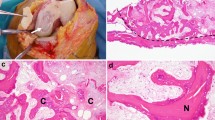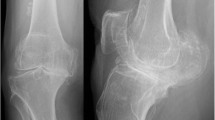Abstract
Background
Chondral or osteochondral defects have been reported in 60–67 % of patients in studies reporting knee arthroscopies. The surgical management of chondral and osteochondral defects (OCD’s) of the articular surface of the knee joint remains a controversial topic. Osteochondral injuries can be treated with transfer cartilage procedure and with implantation of biodegradable scaffolds. For patients over 50 years old with largest osteochondral lesions, we prefer to use the biodegradable scaffold, like Trufit® plug (Smith & Nephew, Andover, MA). The purpose of this study is to evaluate the outcome of this series of surgical procedure with Trufit.
Methods
In our institute, the Trufit was used for the treatment of one or more focal osteochondral lesions of the femoral condyles positive MRI with or without concomitant ligamentous or meniscal pathology. We reviewed 30 patients with mean age of 60.57 years (range 32–79 years) with a clinical and imaging control at 6, 12, 24 and 48 months of follow-up.
Results
The clinical evaluation has shown the good outcome. The MRI conducted has shown the progressive partial integration of the scaffolds.
Conclusions
The results obtained indicate a clear improvement of the clinical symptoms and slowing joint degeneration. The clinical and imaging results confirm that the Trufit constitutes a valid surgical alternative in case of focal osteochondral




Similar content being viewed by others
References
Siclari A, Mascaro G, Gentili C, Cancedda R, Boux E (2012) A cell-free scaffold-based cartilage repair provides improved function hyaline-like repair at one year. Clin Orthop Relat Res 470:910–919
Kirk JT, Cossey JA (2011) Techniques for cartilage repair in chondral and osteochondral defects of the knee. Acta Orthop Belg 77:152–159
Khan IM, Gilbert SJ, Singhrao SK, Duance VC, Archer CW (2008) Cartilage integration: evaluation of the reasons for failure of integration during cartilage repair. A review. Eur Cells Mater 16:26–39
Melton JTK, Wilson AJ, Chapman-Sheath P, Cossey AJ (2010) TruFit CB bone plug: chondral repair, scaffold design, surgical technique and early experiences. Expert Rev Med Devices 7:333–341
Dhollander AAM, Liekens K, Almqvist KF, Verdonk R, Lembrecht S, Elewaut D, Verbruggen G, Verdonk PCM (2012) A pilot study of the use of an osteochondral scaffold plug for cartilage repair in the knee and how to deal with early clinical failures. Arthrosc J Arthrosc Relat Surg 28:225–233
Carmont MR, Carey-Smith R, Saithna A, Dhillon M, Thompson P, Spalding T (2009) Case report: delayed incorporation of a TruFit plug: perseverance is recommended. Arthrosc J Arthrosc Relat Surg 25:810–814
Barber FA, Dockery WD (2011) Computed tomography scan assessment of synthetic multiphase polymer scaffolds used for osteochondral defect repair. Arthrosc J Arthrosc Relat Surg 27:60–64
Gomoll AH, Madry H, Knutsen G, Van Dijk N, Seil R, Brittberg M, Kon E (2010) The subchondral bone in articular cartilage repair: current problems in the surgical management. Knee Surg Sports Traumatol Arthrosc 18:434–447
Author information
Authors and Affiliations
Corresponding author
Ethics declarations
Conflict of interest
None.
Rights and permissions
About this article
Cite this article
Dell’Osso, G., Bottai, V., Bugelli, G. et al. The biphasic bioresorbable scaffold (Trufit®) in the osteochondral knee lesions: long-term clinical and MRI assessment in 30 patients. Musculoskelet Surg 100, 93–96 (2016). https://doi.org/10.1007/s12306-015-0383-y
Received:
Accepted:
Published:
Issue Date:
DOI: https://doi.org/10.1007/s12306-015-0383-y




